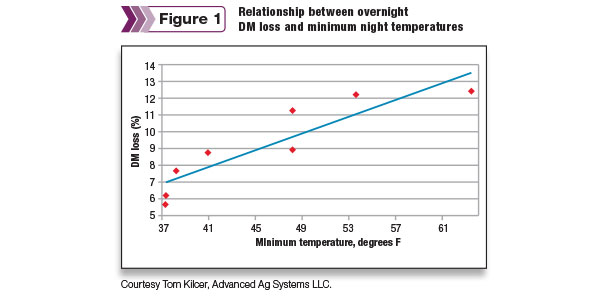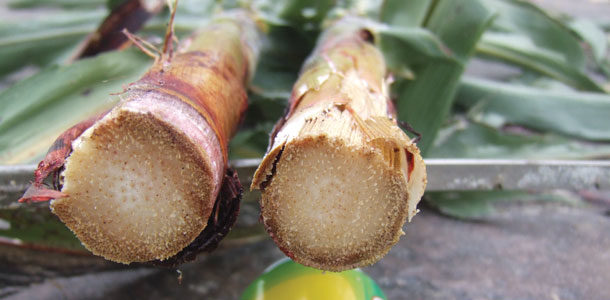They like sugar too, and dairy nutritionists have a rule of thumb that sugar should not exceed 5 percent of the total ration. But should it be included at all? Can’t we get the same energy out of starch?
Research shows that sugar has some benefits in ruminant diets. Sugar is more rapidly fermentable in the rumen than starch, which is a good thing if there is ammonia in the rumen from the breakdown of rumen-degradable protein. Without sugar, this valuable nitrogen would be lost and excreted.
There is also evidence that sugar does not negatively impact rumen pH to the extent that starch does. So while on paper sugars and starches may be treated as equal sources of energy, they can have different effects in the rumen and different impacts on performance.
Everyone knows that sugar tastes good, including ruminants. There is a popular video from Idaho showing cows fighting over hay that was cut in the afternoon versus hay cut in the morning (more on that later).
What they were actually fighting over was the higher sugar in the forage from the afternoon cutting. Grazing livestock almost always prefer grasses to legumes if given the choice.
When it comes to making silage, bacteria that ferment the forage also need sugar, and high-sugar forages ferment faster and more completely than low-sugar forages.
So there are compelling reasons to have high-sugar forages, but how do you get them? It’s important to realize that different forage species have different sugar levels.
Also, sugar levels vary in plants throughout the day in a predictable pattern. Addressing the species issue first, grasses and members of the sorghum family are among the forages highest in sugar content.
Legumes are generally the lowest in sugar. An easy way to incorporate more sugar into your livestock’s diet is to grow grass with alfalfa or put in some forage sorghum in place of corn for silage harvest.
Sugar management – East vs. West
Management is ultimately the key to harvesting high-sugar forages. Many of you have probably heard of the AM/PM hay research done in Idaho.
We get many calls each year in the Midwest from producers who tried to cut hay in the afternoon but when the feed test came back, it was no better than morning-cut hay.
Producers out West believe that afternoon-cut hay is definitely better. Who is right? They both are. The key is understanding how sugar levels fluctuate in plants and in understanding plant respiration (breathing, if you prefer that term).
Photosynthesis uses sunlight to build sugars in the plant all day. So sugar levels are highest in the afternoon when the sun has been out for a long time.
Conversely, sugar is lowest in the early morning before the sun is up because the plants have been burning sugar all night long without being able to make any.
Respiration is the process of burning sugar. If you cut any forage plants, they will continue to respire until they dry down to about 40 percent moisture. Respiration rate is faster at high temperatures and lower in colder temperatures.
So applying this to our hay scenario: Out West, hay is cut in the afternoon when the level is highest. It still may be above 40 percent moisture when night comes, but the temperatures drop drastically at night, which slows respiration.
Humidity is low, so hay may actually dry slightly at night. In the morning, the hay cut the previous afternoon is still higher in sugar than the forage that is still standing uncut.
That is the only reason afternoon-cut hay is higher in sugar out West. In the humid East, hay cut in the afternoon is almost always still above 40 percent moisture by nightfall, but the higher temperatures and humidity keep respiration cranking all night.
Forage harvested in the afternoon is no higher in sugar than standing forage by morning. Soon after the sun comes up, the standing forage may be higher than the afternoon-cut hay.

In addition, dry matter losses overnight can exceed 10 percent, and the worst part is almost all of that dry matter loss is sugar that the plants burned during the night. Figure 1 shows the relationship between temperature and dry matter loss overnight.
So what can producers in the East do to harvest forage that retains high sugar levels? Tom Kilcer of Advanced Ag systems in New York set out to answer that question when he served as an extension agent for Cornell University.
The answer came in another system you may have heard of called “haylage in a day.” Kilcer was one of the pioneering researchers of this system.
They found that in the East, the key was wide swathing, defined as laying windrows as wide as at least 85 percent of the cutting width.
Do this in the morning and ted the hay when the top is dry, which will only take a few hours. In a few hours after tedding, the haylage is at the proper moisture (60 to 65 percent) often by mid-afternoon on the same day it was cut.
The sugar levels in this forage can rival Western afternoon-cut hay if the sun is shining throughout the whole process. Certainly, this will be the highest-sugar forage possible in that environment.
Sugars in grazing
What if you graze livestock rather than make hay? There are still some ways you can manage to capitalize on high-sugar forage for your animals as well.
Some interesting work done by Dr. Gregorini in the U.S. and South America showed a benefit to rotating beef cattle to new pasture in the afternoon rather than the morning, resulting in a significant increase in average daily gain.
Two things are in play here: First, the sugar content is highest in the afternoon, which translates to the forage being higher in energy. Second, most animals graze longer in the evening than any other time of day.
So giving cattle fresh pasture when it is highest in energy and when they are naturally inclined to eat more can result in higher intakes and higher gains.
Remember, if you want high-sugar forage, swath it wide and don’t leave it on the ground overnight if possible. When it comes to making haylage, nearly all the drydown is occurring through the leaves, and the leaves must be exposed to sunlight for the process to work. In a dry hay situation, try to get the hay down to 40 percent moisture in a single day if possible.
And give afternoon pasture rotation a try to see if you can pick up some extra gains. Sugar can do things in the rumen that starch cannot, and it does not contribute to acidosis as significantly as starch does. In the end, diets formulated with some sugars can provide the energy without the negative effects of too much starch. FG

Chad Hale
Past Chair
Cool-Season Grass Initiative












